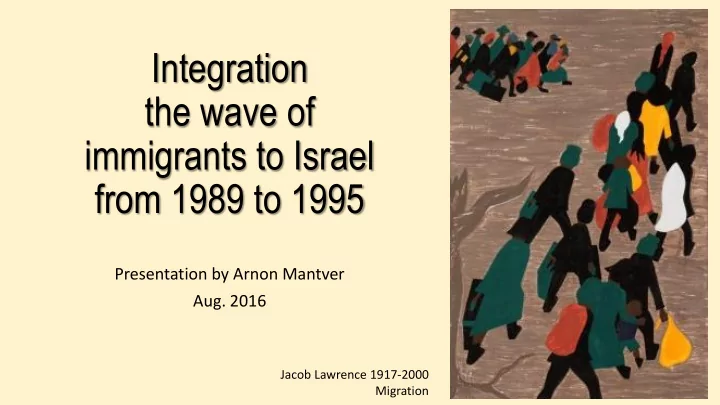

Integration the wave of immigrants to Israel from 1989 to 1995 Presentation by Arnon Mantver Aug. 2016 Jacob Lawrence 1917-2000 Migration
A personal story… • It was in March 1989 …. • Deputy Minister of Finance Dr. Yossi Beilin, July 1989 • In 3 months Oct- Dec 1989 – 12000 New Immigrants from the USSR 600,000 in 5 years; 1 Million in 10 years
Immigration from the USSR to Israel 1990-2001 היילע תנש יפל ,רבעשל מ"הירב ילוע תייסולכוא -. 1 םישרת 1002 ףוס 160 140 120 100 thousands םיפלא 80 60 40 20 0 199019911992199319941995199619971998199920002001 היילע תנש Year of migration
Immigrants, with academic degrees , {FSU} employed in Israel Area Immigrants Israelis Science, engineering 61% 52% & health Humanities, social sciences 37% 47% education & law Other 2% 1% Engineers & architects 82500 Writers & artists 16500 Physicians 17000 Scientists 12000 Between the years RN para-medical workers 18500 Teachers 39000 1989 – 1998:
Im Immigration to Is Israel fr from Ethiopia 48 48,900
Immigration to Israel from Ethiopia Before Operation Moses (pre-1984) 6,000 Operation Moses (Nov. 1984-Feb. 1985) 7,000 Mar. 1985-23 May 1991 11,000 Operation Solomon (24-25 May 1991) 14,300 Post Operation Solomon (through 1997) 11,500 Total 48,900
Relative magnitude of migration to population to Israel and to Germany Israel Germany Simulation of Germany today
A macro view – Integration policies • Initial integration • Employment • Social integration
Policies of Initial Integration – Macro principles Tent cities – British army barracks 1948 - 1967 Public housing in development towns Direct Absorption All under one roof: “ ulpan ” Hebrew -teaching 1967 - 1989 programs, day care, social services Geared to professionals and academicians Absorption Centers Special populations: Ethiopians, students Integration "basket" - Covering all initial 1989 - Present expenses* € New Direct Absorption NIS 53,212= $12,600 * Rent, Living stipend, education fees, health insurance
Employment – Macro principles Number of 1 Needs migrants and of the market their capacity 2 • Language, age, culture & gender • Integration of young adults Major difficulties • Licensing requirements in the labor market • Mismatch with location of home • Suitable jobs
Social Integration - Macro principles • Social tensions – the Israeli experience • "Anti-immigrant" stance – oppose supporting immigrants • "Pro-immigrant" stance – in favor of helping immigrants • Campaigns in the mess media • Interpersonal communication – neighborhoods and cities
Micro View - Integration • Early Childhood (birth to 6-8 years old) • Women • Young Adults
Integration :Ethiopian immigrants Early Childhood (birth to 6-8 years) - the PACT project Research Findings: • Narrowing gaps between locals and immigrants • Strong impact if exposed from birth • Maximizing achievements • Still big gaps between Ethiopians and local kids
Women FSU Ethiopian • Growth in birth rate ■ Big improvement since the 90's • Large number of single-parent ■ Employment: 25% increase in families employment from 23% to 48% • Improvement in Hebrew & ■ Education: 62% graduate elementary Computers education, 15% higher education • Financial difficulties, especially at ■ older ages Many single-parent families – families headed by mothers • High number of marriages with other ethnic social groups ■ Decrease gaps with men in education & • Downgrading of professional level employment
Students & Young Adults FSU Ethiopian ■ Matriculation legibility - 46% ■ Matriculation eligibility - 64% ■ High-school dropouts - 30% ■ High-school dropouts - 12% ■ Higher education – 1,500 – 2000 ■ Higher education: big increase in students number of students 6,000- t0 42,000 ■ Racist incidents - 30% claimed they faced racist incidents ■ Alienation - 24% feel alienation
20 years later – Immigrants from the FSU Encouraging outcomes Challenging issues ■ • Majority feel at home Many elderly & single-parent families face serious economic difficulties ■ 50 % of elderly families don’t own an • Improvement in local language apartment ■ Older immigrants don’t speak the • Improvement in employment. local language. With time, more work in their ■ High dropout rates among high professions. Like Israelis. school students • Standard-of-living like native ■ Many immigrants don’t work in their Israelis professions in the first years
Ethiopian immigrants – since Operation Solomon, May 1991 Encouraging outcomes Challenging issues • 31% claim that local population holds negative attitudes • 74% satisfied with integration towards Ethiopians, 26 % dissatisfied 22% disturbed by cultural differences • 89% feel at home Housing - 40% have difficulties • In 4 out of 5 areas of integration, Young adults & single-parent families report on improvement Number of families with economic difficulties and debt • Employment – number of still high 35% (down from 50%) immigrants that were struggling decreased 37% to 9% Racal issues - demonstrations
Major dilemmas in Integration & Migration Dependence vs. independence Melting pot - multicultural - nativism Mixed flows : Economic migration vs. asylum seekers & refugees Integration policy: universal vs. culture-sensitive Contribution vs. required investment Immigration policy : human right to immigrate vs. sovereignty of states Government policies vs. civil society's stance
Looking Toward the Future (based on the Israeli experience) • Migration can contribute tremendously to manpower, diversity, cultural richness, economic development • It's in the hands of the players: governments, civil society and the immigrants themselves • We must do what is possible to bring about the positive outcomes and minimize the negative ones
Recommend
More recommend